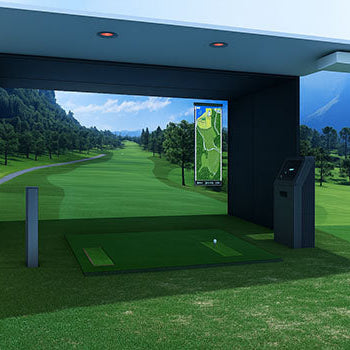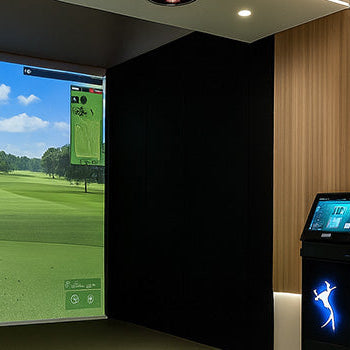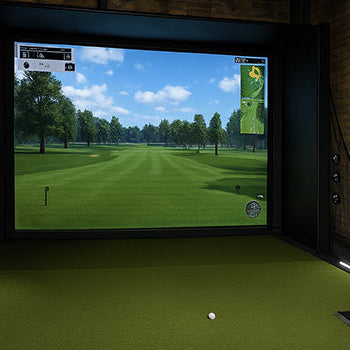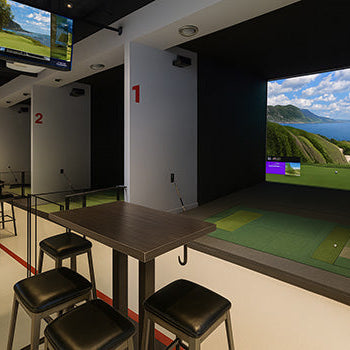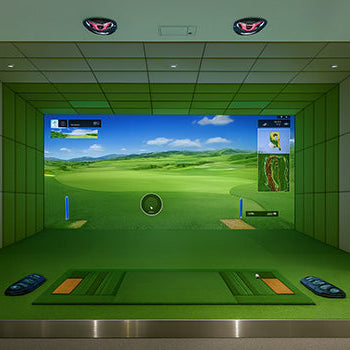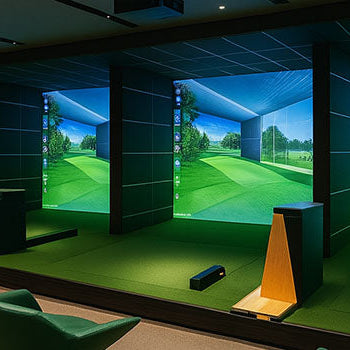Think your old 7-iron’s retired? Think again.
Short answer: You don’t need your own clubs, but they’ll make your golf simulator experience way better. From real feedback to familiar feel, the right gear makes a difference. Read on to find out when to rent, bring, or buy.

Visiting a Commercial Simulator Bar or Venue
The General Rule: Rental Clubs Are Almost Always Available
If you're visiting a commercial golf simulator venue, don’t stress about packing your clubs. Most places offer rental sets by default.
Think of it like bowling, you don’t need your own shoes to play. This makes simulator bars perfect for beginners, casual golfers, or spontaneous weekday sessions.
What to Expect from Rental Sets (Quality and Options)
Rental sets are usually decent but basic. You’ll get mid-range clubs, brands like Wilson or Callaway, with enough variety to get through a round.
Don’t expect a full 14-club tour bag, but you’ll likely have a driver, a few irons, and a wedge. It's enough to have fun and get solid data.
Is There a Fee for Renting Clubs?
Some venues include rentals in the simulator price. Others charge a small fee, typically £5 to £15 depending on the location and set quality.
It’s not a dealbreaker, but check ahead. That way, you’re not caught off guard or dipping into your drink budget for unexpected extras.
Calling Ahead: The Smartest Thing You Can Do
It might seem obvious, but calling ahead is the easiest way to avoid surprises. Ask if they’ve got left-handed clubs, women’s sets, or junior gear if you need it.
And if you’re wondering “do you bring your own golf balls to a simulator?”, you usually don’t. Most places use special balls designed for tracking accuracy.
The Big Advantage of Using Your Own Clubs
Consistency: Getting Accurate Data for Your Personal Game
A golf simulator is all about feedback, but that feedback only helps if it's based on your actual gear. Using your own clubs ensures the data reflects your real swing.
Swing speed, ball flight, launch angle, it all changes depending on the club. Your clubs give you consistency and accuracy.
Comfort and Familiarity: Swinging with Confidence
You know that one club in your bag you always trust? That’s what makes using your own clubs so valuable. You’re already comfortable with the weight, shaft, and grip.
This lets you swing more confidently and avoid awkward adjustments that mess with your mechanics.
Gapping Your Distances: Knowing Exactly How Far YOU Hit Each Club
One of the best things about a golf simulator is being able to dial in your distances. But rental clubs give you someone else’s numbers.
If you're using your own set, you’ll get exact yardages for each club, making course play more predictable and precise.

For Your Home Simulator Setup
Why Using Your Own Clubs Is Essential for Game Improvement
If you’re investing in a home golf simulator, there’s no reason to use anything but your own clubs. It’s your swing, your goals, your gear should match.
Tracking progress, improving technique, and building muscle memory all depend on practicing with familiar equipment.
Keeping Your Clubs Clean to Avoid Marking the Screen
This part’s easy to overlook. Dirty clubfaces can leave marks on your simulator screen or mess with the sensors.
Give your clubs a quick wipe before you start. It’s a simple habit that helps keep your setup clean and your data accurate.
The Myth of "Simulator-Specific" Clubs
You might’ve heard you need special clubs for your simulator. That’s marketing fluff.
Most modern golf simulators work great with standard clubs. You don’t need to spend hundreds on simulator-only gear. At most, you might use reflective stickers or attachable sensors depending on your system.
What If I'm a Beginner With No Clubs?
Why a Simulator Is a Great Place to Start
Never swung a club in your life? Perfect. Golf simulators are ideal for beginners.
There’s no pressure, no crowd, and no lost balls. You can take your time, learn the basics, and actually enjoy the learning process.
Using Rental Clubs to Get a Feel for the Game
Before you commit to buying clubs, use rental sets to test the waters. Try different weights, shaft types, and grips.
It’s a smart way to figure out what feels right without dropping £500 on clubs you might not love.
Advice on Buying Your First Starter Set
Once you're hooked, and you probably will be. Invest in a starter set from trusted brands like Wilson, Cobra, or Benross.
You don’t need a full 14-club setup. A simple set with a driver, a couple irons, and a wedge is plenty to get started.

Final Checklist Before You Go
Do I Need a Full Set? (Driver, Irons, Wedges)
Not at all. For a casual simulator session, 4–5 clubs will do the trick.
A driver, a mid-iron, and a wedge give you enough variety. But if you’re working on club-by-club distance tracking, bringing the full set makes sense.
Making Sure Your Club Faces Are Clean
Clean clubs = clean data. It’s that simple.
Wipe them down before each session, especially if you’ve been practicing outdoors. Dirt on the face can affect spin rates and mess with sensor accuracy.
Don't Forget Your Golf Glove!
Sweaty hands, slipping grips. No thanks.
Bring your golf glove, even indoors. It’ll help you maintain a steady grip and protect your hands during longer practice sessions.
